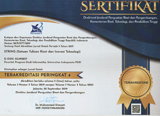Etnomatematika pada Transaksi Jual Beli Pasar Tradisional di Solo
(1) Universitas Indraprasta PGRI
(*) Corresponding Author
Abstract
Keywords
Full Text:
PDFReferences
Hartoyo, A. (2012). Eksplorasi Etnomatematika pada Budaya Masyarakat Dayak Perbatasan Indonesia-Malaysia Kabupaten Sanggau Kalbar. Jurnal Penelitian Pendidikan.
Haylock, D., & Thangata, F. (2007). Key concepts in teaching primary mathematics. Key Concepts in Teaching Primary Mathematics. https://doi.org/10.4135/9781446214503
Heirdsfield, A. M. (2003). “Spontaneous” Mental Computation Strategies. Proceedings of the 27th Conference of the International Group for the Psychology of nMathematics Education Held Jointly with the 25th Conference of PME-NA.
Hennessey, M. N., Higley, K., & Chesnut, S. R. (2012). Persuasive Pedagogy: A New Paradigm for Mathematics Education. Educational Psychology Review. https://doi.org/10.1007/s10648-011-9190-7
Huberman, A., & Miles, M. (2012). The Qualitative Researcher’s Companion. The Qualitative Researcher’s Companion. https://doi.org/10.4135/9781412986274
Karnilah, N. (2013). Jurnal Study Ethnomatematics. Study Ethnomathematics: Pengungkapan Sistem Bilangan Masyarakat Adat Baduy.
Larsen, T. (2013). E.B. tylor, religion and anthropology. British Journal for the History of Science. https://doi.org/10.1017/S0007087412000039
Mabbott, D. J., & Bisanz, J. (2008). Computational skills, working memory, and conceptual knowledge in older children with mathematics learning disabilities. Journal of Learning Disabilities. https://doi.org/10.1177/0022219407311003
Pan, A., Daley, S., Rivera, L. M., Williams, K., Lingle, D., & Reznik, V. (2006). Understanding the role of culture in domestic violence: The Ahimsa Project for Safe Families. Journal of Immigrant and Minority Health. https://doi.org/10.1007/s10903-006-6340-y
Rosa, M., & Orey, D. C. (2011). Ethnomathematics: the cultural aspects of mathematics. Revista Latinoamericana de Etnomatemática.
S. Sirate, F. (2018). IMPLEMENTASI ETNOMATEMATIKA DALAM PEMBELAJARAN MATEMATIKA PADA JENJANG PENDIDIKAN SEKOLAH DASAR. Lentera Pendidikan : Jurnal Ilmu Tarbiyah Dan Keguruan. https://doi.org/10.24252/lp.2012v15n1a4
DOI: http://dx.doi.org/10.30998/string.v3i3.3590
Refbacks
- There are currently no refbacks.
Copyright (c) 2019 Mei Lestari

This work is licensed under a Creative Commons Attribution 4.0 International License.
STRING (Satuan Tulisan Riset dan Inovasi Teknologi) indexed by:

Ciptaan disebarluaskan di bawah Lisensi Creative Commons Atribusi 4.0 Internasional.
View My Stats

 Sertifikat Akreditasi
Sertifikat Akreditasi
















